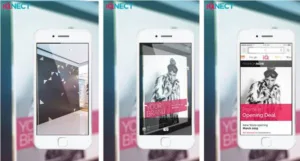When we refer to augmented reality technology we often make a mental connection to head-mounted devices, even though most augmented reality applications will continue to run on mobile devices such as smartphones and tablets. This is true for games as well as business applications.
In most cases, AR is connected more to business applications, while VR is more closely associated with entertainment such as movies and games. As a matter of fact, virtual reality is a little counterintuitive as a supporting medium for business applications. Business applications are intended to support productivity and advertise products and services in an attempt to increase sales. It seems that this is served best by connecting the consumer to the respective product in the real world.
This is the approach of iQNECT, a Singapore-based privately held company that focuses on new technologies in supporting brands. They work with marketers, agencies, publishers and e-commerce companies to bring their respective messages to the digital world. They specialize in image recognition, video recognition, voice recognition, music recognition, analytics, augmented reality and proximity marketing.
In a recent interview by e27, Niamh Byrne, COO of iQNECT said that visual search and augmented reality are a new frontier for brands. The following image shows how this is supposed to work.
Source: iQNECT
When taking an image of a place, product, QZR, barcode, etc. the iQNECT solution displays relevant information or even special offers to the consumer. This contrasts with traditional email marketing where someone has to sign up to receive specific offers. In this case, the interaction is purely passive based on opening the iQNECT app. From there, the user can complete all the interaction as desired.
This is somewhat similar to Blippar, where brand symbols are being used to show exclusive content supplied by the brand. The iQNECT solution goes one step further by providing a form of augmented reality coupon to the consumer.
This new form of mobile interaction has to compete with traditional marketing tools including mobile marketing. One of the key issues for all new forms of mobile marketing is the acceptance by the brands and agencies who have to compare this new AR-based marketing model to other techniques in terms of cost efficiency. It took the mobile marketing approach many years to gain any significant acceptance with the brands and it is unclear if the use of augmented reality will gain any faster acceptance.
Earlier this year, Juniper Research released its market research into enterprise based augmented reality-based applications and sees this market increasing by a factor of ten between 2014 and 2019 (from US$247 million to US$2.4 billion respectively). This is a significant increase, but it still small compared to a $600 billion global advertising market.
Analyst Comment
The iQNECT solution seems to be a much more straightforward approach to incorporating augmented reality technology into marketing solutions. It still requires the user to load an app and look at the products or brand symbol to get the content or offers on their device. It seems that augmented reality requires a “layer of sorts” between the user and the real world to function as a screen showing augmented reality content when triggered. This function is accomplished by the display panel in the mobile device or the virtual display provided by head-mounted smartglasses. In the case of the mobile display, this function is not so easy to accomplish with a mobile display panel and the functionality lacks ease of use compared to a head mounted virtual display. This may for now limit the usability of augmented reality based marketing in the real world. (NH)

